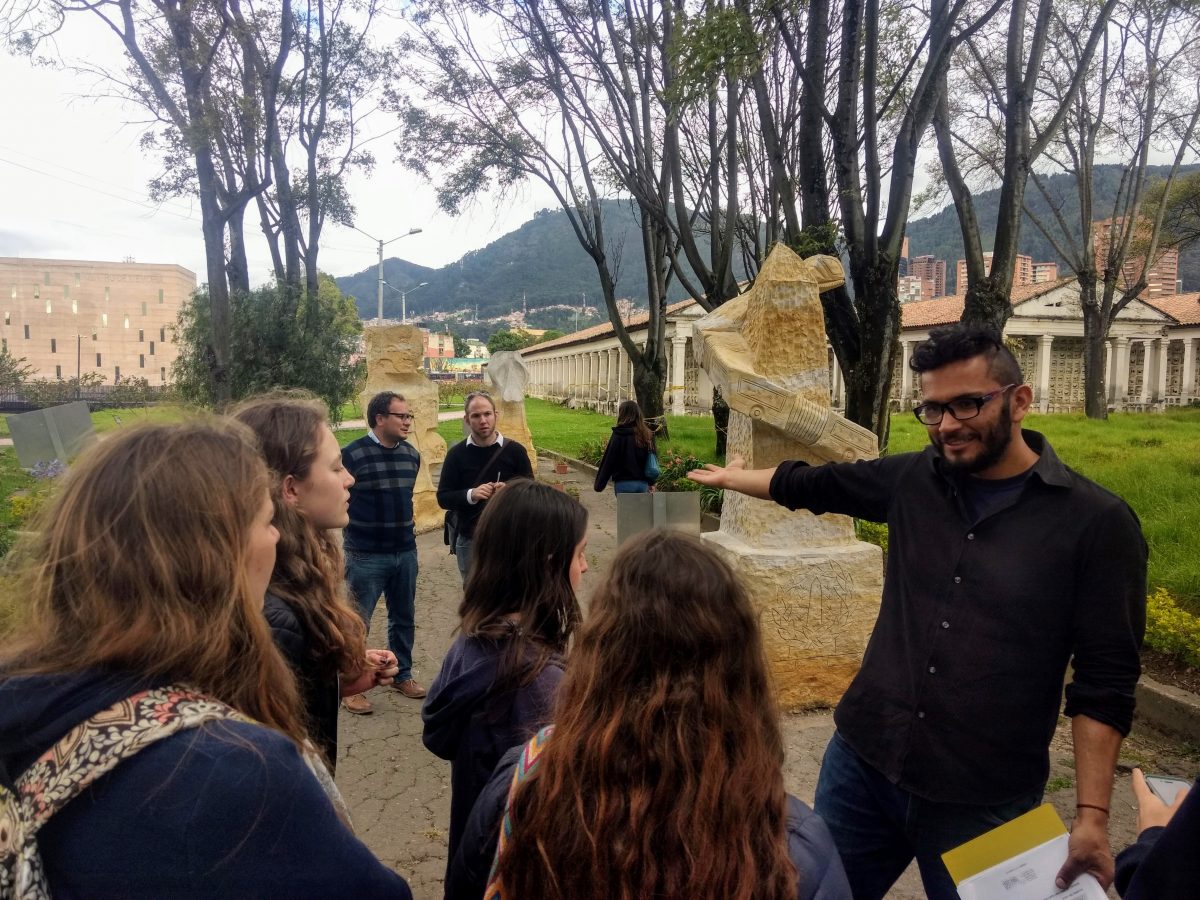Colegio Los Nogales’ Global Studies Concentration Programme
Posted: 12 March 2019

As part of an analysis into the scope and sequence of the high school curriculum, the school leadership team observed that there could be more opportunities for interdisciplinary subject connections. Students engage with their subjects in linear contexts, almost as if they existed in their own discrete boxes. We believe that knowledge is not something that should be compartmentalised by academic disciplines because courses related to politics and economics, for example, cut across many subject and knowledge areas.
We reflected on the fact that linear models of learning can propagate this limited way of thinking and thus determined to find a way to teach with a more interdisciplinary approach. We considered how education in the 21st Century needs to address modern society and many of the situations and issues we face require multiple perspectives in order to attain broader knowledge and deeper understanding.
A group of experienced English and Social Studies teachers reached out to the school leadership team and submitted a proposal for delivering a new interdisciplinary programme. Teachers observed that they were covering similar content and skills, but from a different focus and context, and recognised the value of making more interdisciplinary connections between these courses.
Authors: Tammy Dobrzynski (English Teacher) and Terrence Dillon (Social Studies Teacher)
Planning
The planning for the programme began in the fall of 2017. We started by sequencing the English and Social Studies curriculums and found that there were even more things we had in common than we anticipated and, by combining these, we could delve deeper into these topics. Both departments, for example, were looking at the subject of media structures and media dissemination but from different lenses.
We collaborated to define a three-year Global Studies programme, beginning in tenth grade, which brought together common aspects of our subjects under seven key themes:
1 – Culture and diversity
2 – Economic development
3 – Globalisation and sustainability
4 – Human interactions
5 – Media structures and information literacies
6 – Conflict and peace
7 – Political philosophy and civic participation
In defining these themes, we looked to a number of sources for inspiration including Round Square and the Discovery Framework, the United Nations’ Global Development Goals and other Global Studies programmes in the United States. We also worked with the school’s pedagogical framework, Teaching for Understanding (TfU), to further develop student-centred assignments and projects.
Over time, students select three themes to focus on and choose one theme on which to base their final dissertation. Although the dissertation focuses on one theme, students draw upon the perspectives and understanding developed through the other course themes.
The broad structural focus for students across their years of study is as follows:
Year 9 – Apply to the programme before the end of the year
Year 10 – Explore local, national and global issues
Year 11 – Develop critical thinking and research skills
Year 12 – Apply knowledge to help solve local, national or global issues
We were pleased to discover that there was interest from the student body in this new interdisciplinary programme, but recognised that in terms of resources, we had to manage student numbers. We agreed that smaller cohorts (5-10 students per grade level) would also ensure the integrity and value of the course by enabling students to collaborate with those with common interests and motivation for the subject.
A process was established to help select participating students. We decided that they needed to:
- Complete a formal application with details of their academic performance and recommendations from their English and Social Studies teachers.
- Demonstrate interest, talent and motivation in English and Social Studies.
- Submit a personal statement and include the reasons why they wanted to study the course
The students have to commit to the entirety of the three-year programme, so gauging their interest and motivation was crucial in determining the final selection. The first course began in the spring semester of 2018.
The programme is delivered by the English and Social Studies faculty with support from the International Programmes Director and Round Square Representative and the Social Service Director to support the extracurricular and experiential program components.
Programme Description
A variety of learning approaches are utilised to deliver the content of the course and create the students’ portfolios of learning. The portfolios include three components: academic, extracurricular, and experiential. These components are tied together via electronic portfolios which includes academic assignments, multimedia artefacts that document extracurricular and experiential activities, a curriculum vitae, and guided reflections.
Within the curriculum, there are academic assignments drawing upon Teaching for Understanding (TfU), a Backwards Design process, and a focusing on Higher Order Thinking skills. Through debates, tribunals and research essays, students examine subjects such as Colombian history, Latin American history, current events, political science, economics and human geography in the social sciences as well as composition, literature, and research methods in the English Language Arts.
Extracurricular activities are also embedded in the programme. Students are expected to participate in Model United Nations, Round Square, or both. Opportunities for experiential learning are also encouraged through an exchange (or virtual exchange) or participating in community service work (mentoring at a public school or helping build homes in a community). All of these marry well with the IDEALS values and incorporate many of the academic skills in the Discovery Framework, such as the ability to solve problems.
The programme concludes with a student-led scaffolded research essay exploring one of the themes. The topic is purposefully set to be exploratory and should be guided by analysis and evaluation. Students are required to partake in an oral defense of their research project as well as deliver a formal presentation at a conference-style event in front of all the high school students. Students who complete all the portfolio requirements successfully receive a Global Studies Concentration Diploma upon graduation.
Challenges
Like many schools, the existing school structure is vertical, so the implementation of an interdisciplinary, horizontal approach presents structural and logistical challenges. We had to agree on who took ownership of the program, who runs the budget, and this involved close collaboration with colleagues who may have different ways of doing things and different personalities. The students have adapted more easily to this expanded way of learning. As the programme has developed, we are slowly seeing a culture shift and greater interest in interdisciplinary work, and teachers in other subjects have expressed an interest in following our model.
Impact
The school’s learning management system (LMS) is a critical resource that enables the students to build a portfolio to capture their written work and photographic evidence of the activities they have participated in. Having this archive available is helpful to students when applying to university as they are able to export relevant content for their university applications. The platform also enables students and teachers to comment on others’ work, collaborate and share learnings.
Although the course is still relatively new, we can see that the students are becoming more open-minded about different issues, employing critical thinking and working at a more advanced level.
We are amassing a body of evidence that will examine this more closely and we have asked students to regularly reflect on the impact of the program intellectually, emotionally and socially. Students are encouraged to analyse and evaluate their progress at the end of every semester, reflecting on their growth in terms of the course content and their own ideas.
Field trips and Town Hall Meetings also encourage experiences to be shared. For example, the students who participated in the RSI-Round Square Research Project at Harvard University will present to staff and students on their observations and learnings from the workshop as part of a Q&A discussion.
As we continue to assess how the programme impacts students and influences their thinking (both positively and negatively), we refer to Bloom’s Taxonomy to track progress and fine tune the programme itself but in reality, we are unlikely to get the full picture on impact until our first cohort of students has participated in the entire programme (2-3 years from now).
Other areas of influence are also being observed and captured; the popularity of exchanges being one such example, but also students’ engagement in their subjects. Over the last five years, we have seen active engagement in classes and we hope that interdisciplinary learning will grow as students are better able to contextualise and personalise their learning. About 25% of students are now opting to study a Social Science degree at university, and this may well be another yardstick by which we measure interest and engagement in the future.
We are also looking closely at the impact on teachers, content wise and philosophically, the extent to which there is a greater understanding and more defined connections between subjects, and appetite to formalise these connections through interdisciplinary work.
The Future
We have 21 students participating in the program at present and expect to increase these numbers to a maximum of 30 students (15% of the student populace).
Advice
- Widen your own vision! Get out of the classroom and see what is happening in other classrooms. Talk to other teachers and start conversations.
- Start the ball rolling with some type of collaboration. Students are really open to this, so let them lead in driving this.
- Ensure faculty have time in their schedules for professional development. We are assigned an hour a week to meet and talk.
